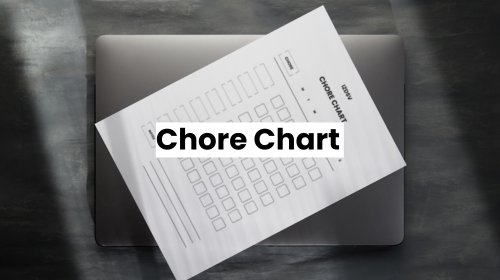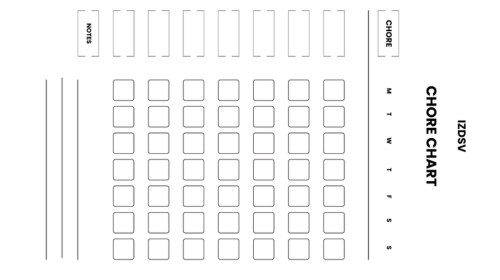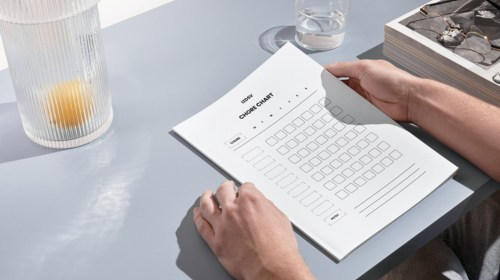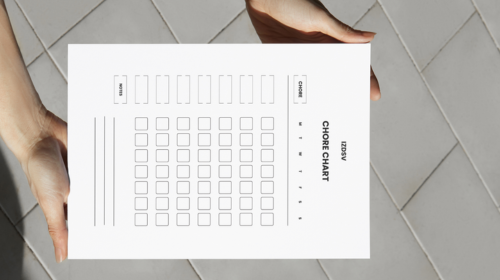Discover the Best Chore Chart for Your Children’s Tasks
What is a Chore Chart and How Does It Work?
A chore chart is a visual tool used to organize and track household tasks assigned to family members. It typically displays a list of chores along with names or pictures of family members, allowing for clear task delegation and accountability.
- A physical chore chart might be a poster, whiteboard, or printout hung in a visible location
- Digital chore charts can be apps, spreadsheets, or shared online documents
- Tasks are usually listed with their frequency (daily, weekly, monthly)
- Completion is tracked through checkmarks, stickers, or digital indicators
- Chore charts can include reward systems to motivate participants
- They serve as visual reminders and create structure for household management
Understanding the Purpose of a Chore Chart
The primary purpose of a chore chart is to distribute household responsibilities fairly among family members while creating a system of accountability. It eliminates confusion about who should do what and when, reducing household tension and teaching important life skills.
- Establishes clear expectations for everyone in the household
- Creates a visual reminder of responsibilities
- Helps build routine and structure
- Reduces the need for verbal reminders and nagging
- Teaches responsibility and contribution to family life
- Provides a system to track task completion
- Can reduce arguments about fairness in task distribution
- Helps maintain household cleanliness and organization
Benefits of Using a Chore Chart for Kids
Chore charts help children develop essential life skills while teaching them about responsibility and contributing to family life. They create a structured approach to household duties that helps children understand expectations and experience the satisfaction of completing tasks.
- Teaches responsibility and accountability
- Builds independent living skills early in life
- Develops time management abilities
- Creates a sense of accomplishment and pride
- Helps children understand their role in family functioning
- Establishes work ethic and routine
- Can boost self-esteem when tasks are completed
- Provides opportunities to learn new skills
- Can be tied to allowance or reward systems for financial literacy
- Reduces parent-child conflict over chores
How to Create an Effective Chore Chart
Creating an effective chore chart involves selecting age-appropriate tasks and designing a system that is both motivating and easy to maintain. The most successful charts balance clarity with flexibility and include elements that make tracking progress simple for everyone involved.
- Assess your household needs and list all necessary chores
- Assign tasks based on age and ability levels
- Decide on chart format (digital or physical)
- Choose a tracking method (stickers, checkmarks, movable pieces)
- Establish clear time frames for task completion
- Consider including pictures for young children
- Determine if rewards will be incorporated
- Keep the design simple and easy to understand
- Place the chart in a highly visible location
- Include a way to rotate chores if desired
- Involve everyone in the chart creation process
How to Customize a Printable Chore Chart
Customizing a printable chore chart allows you to tailor the system to your family’s specific needs and preferences. The right customizations can increase engagement and make the chart more effective for your particular household dynamics.
- Select a template that fits your family size and needs
- Add family members’ names or photos
- Include age-appropriate chores for each person
- Use color-coding to differentiate people or types of chores
- Add illustrations or icons for non-readers
- Adjust the frequency indicators (daily, weekly, etc.)
- Incorporate a reward system if desired
- Laminate the chart for durability and reuse
- Use dry-erase markers or movable elements for flexibility
- Add special sections for rotating chores or special projects
- Consider seasonal adjustments for changing household needs
Creating a Chore Chart for Multiple Kids
When creating a chore chart for multiple children, it’s important to balance fairness with age-appropriate expectations while minimizing competition or comparison. A well-designed multi-child chore chart acknowledges different abilities while ensuring that everyone contributes meaningfully to the household.
- Use color-coding to distinguish between children
- Create columns or rows for each child
- Assign age-appropriate tasks to each child
- Consider rotation systems for shared or desirable chores
- Include both individual and team chores
- Ensure equity in workload relative to age and ability
- Design reward systems that work for different ages
- Create opportunities for older children to mentor younger ones
- Include spaces for bonus chores or extra credit
- Establish clear resolution methods for disputes
- Consider including photos or avatars for younger children
How to Implement a Chore Chart in Your Daily Routine?
Implementing a chore chart effectively requires consistency and integration into your existing household routines. The key to success lies in making the chart a natural part of daily life rather than treating it as an additional burden.
- Start with a family meeting to introduce the chart and explain its purpose
- Begin with a small number of chores before expanding
- Establish specific times for checking and updating the chart (morning, after school, before bed)
- Create rituals around chart usage (morning check-ins, evening reviews)
- Be consistent with enforcement and follow-through
- Model chart usage yourself if adults are included
- Provide guidance and demonstrations for new chores
- Build in a brief adjustment period where reminders are given
- Use the chart as a reference during daily conversations
- Celebrate successes regularly in the early implementation phase
- Adjust the system as needed based on what’s working
Integrating a Chore Chart into Kids’ Daily Schedule
Successful integration of a chore chart into children’s routines happens when chores become a natural extension of their daily activities rather than an interruption to them. Thoughtful timing and connection to existing routines increase the likelihood that children will complete their responsibilities without resistance.
- Attach chores to existing routines (before breakfast, after school, before bedtime)
- Create natural sequences (feed pets before your own breakfast)
- Consider energy levels when scheduling (active chores after school, quick tasks in the morning)
- Use visual cues to help children remember their responsibilities
- Set regular check-in times that align with family gatherings
- Incorporate chart reviews into other daily rituals like dinner time
- Use timers or alarms for time-sensitive tasks
- Provide ample transition time between activities and chores
- Keep chore sessions brief for younger children
- Ensure that chores don’t consistently conflict with homework or activities
- Create weekly planning sessions to review upcoming responsibilities
Tips for Encouraging Kids to Follow Their Chore Chart
Encouraging consistent participation with chore charts requires a balance of positive reinforcement, clear expectations, and appropriate motivation. The goal is to foster intrinsic satisfaction in contributing to the household while providing enough external motivation to establish good habits.
- Make initial tasks achievable to build confidence
- Offer specific praise for completed chores (“You folded those towels so neatly!”)
- Allow for choice when possible (“Would you prefer to empty the dishwasher or sweep?”)
- Use positive language about contributions rather than obligations
- Make chores fun with music, timers, or friendly competition
- Work alongside children initially to model and assist
- Share the “why” behind important tasks to build understanding
- Acknowledge progress and improvement over time
- Remain consistent with expectations and consequences
- Create opportunities for teamwork
- Periodically update chores to match developing abilities
- Celebrate milestones with special recognition
Using a Reward Chart Alongside Chore Charts
Pairing a reward system with your chore chart can provide additional motivation while teaching children about work ethics and delayed gratification. An effective reward system balances immediate recognition with longer-term goals and avoids undermining the intrinsic value of contributing to the household.
- Establish clear connections between completed chores and rewards
- Consider point-based systems where tasks have different values
- Balance immediate rewards with longer-term goals
- Include non-material rewards like special privileges or activities
- Create tiered reward systems for different achievement levels
- Keep rewards reasonable and sustainable for your budget
- Gradually transition from external rewards to more intrinsic motivation
- Include surprise recognition for consistent performance
- Consider group rewards for family-wide goal achievement
- Allow children to select meaningful rewards
- Adjust reward systems as children mature
- Ensure rewards don’t overshadow the inherent value of contribution
What are the Best Practices for Using a Chore Chart for Kids?
Effective chore charts strike a balance between structure and flexibility while emphasizing positive reinforcement rather than punishment. Successful implementation requires consistency, clear communication, and adaptability to changing family needs.
- Start simple and gradually increase complexity
- Focus on the process rather than perfection
- Be consistent with expectations and follow-through
- Update the chart regularly as children develop new skills
- Make the chart visually appealing and accessible
- Allow for input from children in task selection when appropriate
- Provide clear, specific instructions for each chore
- Include both daily and weekly responsibilities
- Balancing individual tasks with family contribution chores
- Avoid using chores as punishment
- Maintain a positive attitude about household responsibilities
- Model the behaviors you want to see
- Recognize and celebrate consistent participation
- Include seasonal reviews to assess effectiveness
- Pair visual instructions with written ones for younger children
Setting Age-Appropriate Chores for Different Ages
Age-appropriate chore assignments are crucial for building confidence and ensuring tasks match a child’s developmental capabilities. The right balance challenges children to grow while avoiding frustration from tasks beyond their physical or cognitive abilities.
- Ages 2-3: Simple picking up of toys, putting dirty clothes in the hamper, wiping up spills
- Ages 4-5: Setting the table, helping to make beds, sorting laundry by color
- Ages 6-7: Taking out small trash bins, folding simple laundry, helping with meal prep
- Ages 8-10: Loading dishwasher, vacuuming, helping with grocery lists
- Ages 11-13: Doing laundry independently, preparing simple meals, cleaning bathrooms
- Ages 14+: Deep cleaning tasks, grocery shopping with a list
- Consider motor skills development when assigning tasks
- Adjust expectations based on individual ability, not just age
- Provide appropriate tools sized for children (child-sized brooms, etc.)
- Include a mix of personal responsibility and family contribution chores
- Gradually increase complexity within the same chore category
- Allow for mastery before introducing new responsibilities
- Consider attention span when determining task duration
How to Adjust Chore Lists for Kids with ADHD
Adapting chore charts for children with ADHD requires thoughtful modifications that accommodate attention challenges while still building responsibility and life skills. Effective adjustments focus on structure, clear instructions, and positive reinforcement to promote success.
- Break down larger tasks into smaller, manageable steps
- Use timers to create defined work periods (10-15 minutes)
- Incorporate movement-based chores that allow for physical activity
- Create visual checklists with pictures for each step of multi-step tasks
- Limit distractions in the environment during chore time
- Pair preferred activities with less desirable tasks
- Provide immediate feedback and reinforcement
- Use clear, concise instructions with visual supports
- Build in short breaks between tasks
- Consider executive functioning challenges when setting expectations
- Allow flexibility in when chores are completed within a timeframe
- Focus on one new chore at a time before adding others
- Consider sensory preferences when assigning tasks
- Use checklists to support task completion
- Celebrate small wins and improvements consistently
Incorporating Life Skills into Chores
Thoughtfully designed chore systems teach children practical life skills that extend far beyond keeping a tidy home. When framed correctly, chores become valuable learning opportunities that prepare children for independence and build confidence in their abilities.
- Connect chores to real-world applications and future independence
- Gradually increase responsibility within the same skill area
- Explain the reasoning behind specific techniques
- Include financial literacy through allowance management
- Incorporate meal planning and preparation skills
- Teach basic home maintenance appropriate for age
- Include technology management (device care, simple troubleshooting)
- Add organizational skills through decluttering projects
- Introduce time management through deadline-based responsibilities
- Include social responsibility through community-oriented tasks
- Teach environmental awareness through recycling and conservation chores
- Incorporate basic first aid and safety practices where appropriate
- Add budgeting skills through grocery shopping assistance
- Include clothing care from sorting to washing to minor repairs
- Teach decision-making through chore prioritization
Can a Chore Chart Help with Family Organization?
A chore chart serves as a central organizational hub that can transform how families manage their collective responsibilities and routines. Well-implemented chore charts create structure and consistency that extends beyond just household cleaning tasks.
- Creates a visual system for tracking responsibilities
- Establishes clear expectations for all family members
- Reduces mental load typically carried by one parent
- Minimizes forgotten tasks and last-minute scrambles
- Provides accountability without constant verbal reminders
- Creates predictable household routines
- Helps identify imbalances in workload distribution
- Serves as a communication tool about household needs
- Reduces conflict over who should do what
- Creates opportunities to praise contribution rather than criticize
- Streamlines household operations through systematic planning
- Encourages proactive rather than reactive home management
- Teaches organizational skills to children through modeling
- Frees up mental energy for quality family time
Using a Chore Chart as a Family Responsibility Tracker
A well-designed family responsibility tracker expands beyond traditional chores to encompass all recurring duties that keep a household functioning smoothly. This comprehensive approach ensures that both visible and invisible work is acknowledged and fairly distributed.
- Include responsibilities beyond cleaning (appointments, errands, meal planning)
- Track recurring but infrequent tasks (seasonal maintenance, bill payment)
- Assign ownership for family pet care and management
- Include school-related responsibilities and deadlines
- Track extracurricular activities and associated tasks
- Monitor meal planning, preparation, and cleanup roles
- Manage household inventory and shopping responsibilities
- Assign administrative tasks like scheduling appointments
- Track home maintenance responsibilities
- Include vehicle care and maintenance duties
- Manage social obligations and gift-giving responsibilities
- Organize document management and paperwork
- Include technology maintenance and updates
- Track financial management responsibilities
- Balance load across all family members based on capability
Creating a Weekly Planner for Family Chores
A weekly chore planner provides structure while accommodating the natural rhythm of family life and external commitments. This approach balances predictability with flexibility to create a sustainable system that adapts to changing schedules.
- Designate specific days for routine tasks (laundry day, grocery day)
- Block out busier weekdays with lighter chore loads
- Schedule major cleaning tasks for when most family members are available
- Create morning, after-school, and evening routines for daily tasks
- Balance indoor and outdoor chores seasonally
- Incorporate meal planning with related shopping and prep tasks
- Include both individual responsibilities and family chore times
- Schedule regular weekly maintenance to prevent larger jobs
- Designate “catch-up” periods for flexibility
- Plan ahead for special events or visitors
- Include preparation time for upcoming transitions (back-to-school, holidays)
- Create a visual weekly overview accessible to all family members
- Include regular review and reset time to prepare for the upcoming week
- Balance workload throughout the week rather than concentrating on weekends
- Incorporate family meetings to assess what’s working and make adjustments
Visual Schedules: How They Enhance Family Organization
Visual schedules leverage the power of imagery to communicate expectations clearly, making them particularly effective for children and visually oriented adults. These intuitive tools reduce cognitive load and create accessible systems that promote independence and successful routine management.
- Use pictures, icons, or color-coding for immediate comprehension
- Create visual timelines to demonstrate daily sequences
- Reduce verbal reminders through visual cues
- Support independence for non-readers or early readers
- Help family members with attentional challenges stay on track
- Provide concrete visual progress indicators
- Use visual timers alongside schedules for time management
- Create morning, after-school, and bedtime routine visuals
- Include both chores and self-care activities in visual sequences
- Support transitions between activities with visual cues
- Use photographs of “done” states to clarify expectations
- Implement digital visual schedules for tech-savvy families
- Create portable visual reminders for on-the-go tasks
- Simplify complex processes with step-by-step visual breakdowns
- Reduce anxiety by making expectations and timing explicit
What Types of Chore Charts Are Available?
Chore charts come in a wide variety of formats to suit different family needs, ages, and organizational preferences. The best format often depends on your family’s unique situation, tech-savviness, and the ages of your children.
- Traditional paper charts (printable templates, posters, or handmade)
- Magnetic chore charts with movable pieces
- Dry erase boards with customizable sections
- Chalkboard-style charts for frequent updates
- Digital apps specifically designed for chore tracking
- Spreadsheet-based systems (Excel, Google Sheets)
- Task management apps repurposed for family use
- Peg systems with movable indicators
- Pocket charts with removable cards
- Sticker-based charts for younger children
- Calendar-style charts for weekly planning
- Picture-based charts for pre-readers
- Responsibility wheels that rotate chores
- Token or chip systems for task completion
- Family command center with integrated chore sections
Comparing Printable and Dry Erase Chore Charts
Printable and dry-erase chore charts each offer distinct advantages that make them suitable for different family situations and preferences. The choice between these popular options often comes down to how much flexibility and customization your family needs on an ongoing basis.
- Printable charts offer one-time customization while dry-erase allows continuous adaptation
- Dry-erase charts are more environmentally friendly for long-term use
- Printable options can be replaced weekly for a fresh start
- Dry erase boards often come with built-in organizational features
- Printables can be stored as records of completed chores over time
- Dry erase charts require less ongoing printing costs
- Printables offer more detailed design options and themes
- Dry-erase options are typically more durable for family use
- Printable charts can be custom-designed for specific family needs
- Dry erase charts allow for immediate adjustments to changing schedules
- Printables work well for consistent, unchanging chore routines
- Dry erase boards are easier to update for seasonal chores
- Printable options work better for reward systems with stickers
- Dry erase charts typically have a higher initial cost but lower ongoing expense
- Hybrid systems using laminated printables with dry-erase markers combine the benefits of both
Exploring Digital Chore Charts
Digital chore chart solutions leverage technology to bring advanced features, accessibility, and automation to family task management. These tech-forward options offer unique capabilities that traditional physical charts cannot match, particularly for families with older children or busy schedules.
- Smartphone apps with push notifications and reminders
- Shared digital calendars with recurring chore assignments
- Family management platforms with integrated chore tracking
- Gamified apps that turn chores into quests or challenges
- Smart home integrations that connect with voice assistants
- Digital reward systems with point tracking and redemption
- Cloud-based charts accessible from multiple devices
- Progress tracking with historical data and statistics
- Digital solutions with photo/video evidence of completion
- Automated scheduling and rotation of responsibilities
- Multi-user platforms with individual logins and dashboards
- Digital charts with parental approval requirements
- Integration with allowance management and digital banking
- Family communication platforms with chore assignment features
- Scheduling tools that sync with school and activity calendars
Choosing the Right Chore Chart for Toddlers
Toddler-appropriate chore charts focus on simplicity, immediate visual feedback, and age-appropriate tasks that foster early independence. The ideal chart for this age group emphasizes positive reinforcement and builds confidence through achievable successes.
- Picture-based designs showing the task visually
- Immediate reward systems with stickers or stamps
- Limited number of simple tasks (1-3 initially)
- Charts with larger spaces for small hands to manipulate
- Tactile elements like movable pieces or flaps
- Bright, engaging colors and character themes
- Simple tasks represented (putting toys in bin, throwing away trash)
- Before/after images showing completed tasks
- Interactive elements like velcro, magnets, or pockets
- Morning and bedtime routine sequences
- Self-care tasks integrated with household contributions
- Personalized with toddler’s photo or name
- Visible placement at toddler eye level
- Durable construction that withstands handling
- Immediate feedback mechanisms rather than delayed rewards




